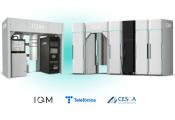NEC Receives Order for Next-Generation Supercomputer System From Japan’s National Institutes for Quantum Science and Technology and NIFS
Tokyo, November 13, 2024 -- NEC Corporation has received an order for a next-generation supercomputer system from Japan’s National Institutes for Quantum Science and Technology (QST), under the National Research and Development Agency, and the National Institute for Fusion Science (NIFS), part of the National Institutes of Natural Sciences under the Inter-University Research Institute Corporation. The new supercomputer system is scheduled to be operational from July 2025.
The next-generation supercomputer system will feature multi-architecture with the latest CPUs and GPUs and will consist of large storage capacity and a high-speed network. This system is expected to be used for various research and development in the field of fusion science research. Specifically, the system will be used for precise prediction of experiments and creation of operation scenarios in the ITER project, which is being promoted as an international project, and the Satellite Tokamak (JT-60SA) project, which is being promoted as a Broader Approach activity, and for design of DEMO reactors. The DEMO project promotes large-scale numerical calculations for DEMO design and R&D to accelerate the realization of a DEMO reactor that contributes to carbon neutrality. In addition, NIFS will conduct numerical simulation research using the supercomputer for multi-scale and multi-physics systems, including fusion plasmas, to broadly accelerate research on the science and applications of fusion plasmas, and as an Inter-University Research Institute, will provide universities and research institutes nationwide with opportunities for collaborative research using the state-of-the-art supercomputer.
The new system consists mainly of 360 NEC LX 204Bin-3s (with a total of 720 Intel Xeon 6900Ps) and 70 NEC LX 401Bax-3GAs (with a total of 280 AMD Instinct MI300As), with total theoretical performance of 40.4 petaflops of computing power. Theoretical computing performance will be approximately 2.7 times higher than the combined performance of the two supercomputers installed separately at QST and NIFS. The NEC LX 204Bin-3 is equipped with MRDIMMs, which have high performance in HPC programs.
The supercomputer system consists mainly of the "LX series," which was developed by combining the high-density packaging technology and high-efficiency cooling technology that NEC has developed over many years in the development of supercomputers. The Intel "CPU Xeon6900P," "MRDIMM," and AMD’s “Instinct MI300A" GPUs installed in these server groups are the first introduction of its kind in Japan. In addition, the network environment uses "InfiniBand" with the NVIDIA “QM9700," "Altair PBS Professional" software, and a scheduler optimized for AMD’s Instinct MI300A. In addition, as a storage environment, a DDN “ES400NVX2" will be deployed with a total capacity of 42.2 petabytes with a Lustre parallel file system "EXAScaler." NEC will integrate these components along with software optimization.
NEC will continue to contribute to the development of cutting-edge technologies by promoting the development of next-generation high-performance servers as a foundation for utilization in industrial applications and AI/Big Data domains, as well as the conventional application areas of supercomputers. NEC will also support research activities in the academic domain by providing academic research information infrastructure with HPC solutions at its core as one of its BluStellar offerings.
“Intel is proud to partner with NEC to power a system at the National Institutes for Quantum Science and Technology and National Institute for Fusion Science. By integrating the Intel Xeon 6900P Series, the first server CPU to support MRDIMMs, and the first in Japan, we’re delivering a leap in memory performance and bandwidth, an ideal choice for complex calculations and simulations required in fusion research.” Said Ogi Brkic, Vice President & General Manager, Go-To-Market Builders & Technology Acceleration Office, Sales & Marketing Group, Intel
“We are very pleased that NEC has chosen to partner with AMD to power the next generation supercomputers ordered by both the National Institutes for Quantum Science and Technology and the National Institute for Fusion Science in Japan. We appreciate that NEC has selected AMD’s Instinct MI300A and this choice is further proof that AMD’s MI300 Series GPUs offer a compelling supercomputer accelerator solution. We believe that AMD innovation, together with NEC's advanced technological capabilities, will continue to make a significant contribution to research conducted at the National Institutes for Quantum Science and Technology, and the National Institute for Fusion Science.” Said Jon Robottom, Corporate Vice President, Representative Director & General Manager, AMD Japan
“DDN is honored to continue to support cutting-edge fusion research at the National Institutes for Quantum Science and Technology and the National Institute for Fusion Science through our strong collaboration with NEC. The combination of DDN's high-performance storage solution and NEC's superior technology will provide stable performance and fast processing of large data sets to power complex simulations and advanced analytics in fusion science research. We are confident that through this collaboration, we will be able to accelerate innovative discoveries and technology development.” Said Robert Triendl, SVP Sales, International, DataDirect Networks, Inc. (DDN)
"With our specialized solutions, Giga Computing is proud to support the missions of both the National Institutes for Quantum Science and Technology and the National Institute for Fusion Science in advancing scientific discovery. For this cluster, our technology is incorporated into the NEC LX series servers with one of our models equipped with Intel Xeon 6900P series processors and MRDIMM technology, while the other uses the AMD Instinct MI300A GPU. This high-performance solution uses efficient liquid cooling to deliver remarkable processing speeds for nuclear fusion and complex plasma simulations. Consequently, it enables the institutes to achieve faster, more accurate results in the field of advanced nuclear fusion research.” Said Freya Yu, Sales Director, Giga Computing
“We are very pleased to collaborate with NEC in the selection of Altair PBS Professional for the next-generation supercomputer system at the National Institutes for Quantum Science and Technology and the National Institute for Fusion Science. We are confident that Altair PBS Professional is the industry's most advanced workload management and job scheduling software for HPC and high-throughput computing, and that it will contribute to improving the productivity of the supercomputer system and optimizing its utilization and efficiency. We will continue to work with NEC to help our customers solve their challenges.” Said Eiichi Kazono, President and Representative Director, Altair Engineering, Inc.
“We are very pleased to have been able to support the construction of a networking environment in partnership with NEC Corporation. The NVIDIA QM9700 is a networking switch that uses high-speed interconnect technology and is optimized for large-scale computing environments, especially for AI and academic research. It demonstrates its true value in data transfer for numerical analysis and simulations that require massive data processing. We are confident that this will further accelerate the research and development projects at the National Institutes for Quantum Science and Technology and the National Institute for Fusion Science and support the technological foundation for more innovative results. We will continue to strengthen our collaboration with NEC on networking products to accelerate the progress of our customers' research.” Said Yukihiro Tsujii, General Manager, Solution Business Division, Ryoyo Electro Co.




































